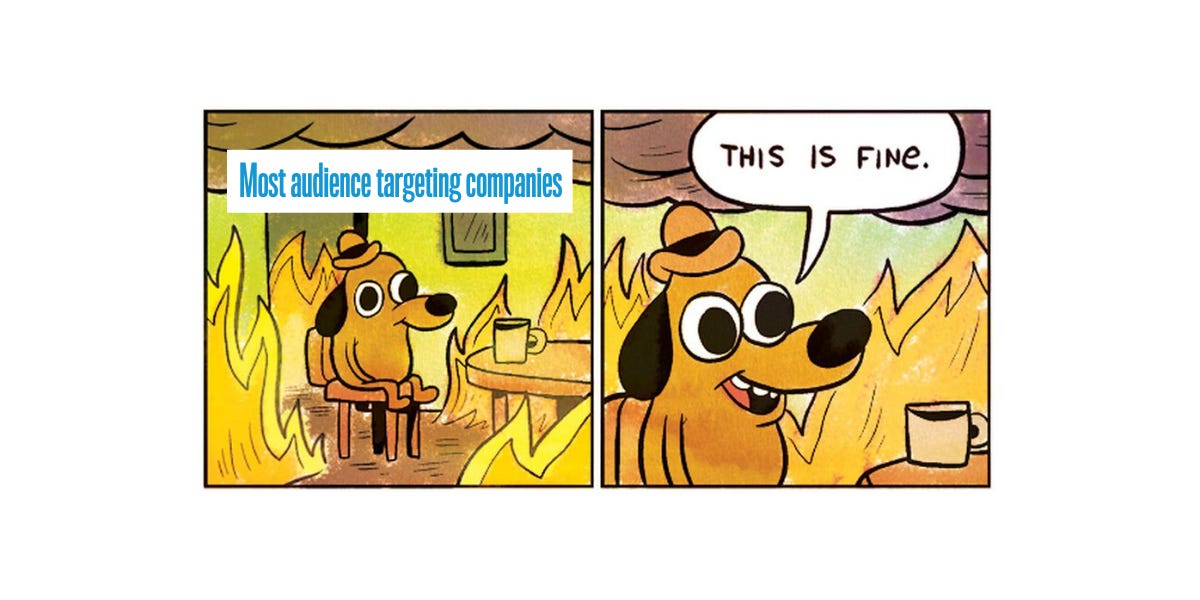A word about Google
Google's re-announcement has the digital ad industry on tilt. Here's who really needs to be concerned.
Google’s re-announcement about its policy on user privacy seems to be dominating the headlines. Most of the “experts” commenting thus far doth protest too much, methinks.

Instead of our originally scheduled programming, let’s review who needs to be concerned and who can take a deep breath (for now).
Do you buy a lot of open-web inventory?
Concern Level: High
Yeah, there’s no gentle way to put this. If you are a heavy buyer of open-web inventory utilizing 3rd party data and DV360 or other Google tools, you are probably going to be sucking some wind for a while.
As the announcement pointed out, user-level targeting inside of Google tools is going to be far more difficult with the exception of Google-owned and operated properties like Search and YouTube. Open Exchange bidding, as we know it today, will fundamentally change.
Your options are to begin rapidly testing Google’s prescriptive alternatives like FLoC, or switch to a different DSP like The Trade Desk, MediaMath, AdForm, etc.
Most of your spending is already concentrated on Google properties and Facebook.
Concern Level: Low
For now, it looks like not much will change. There might be more competition for inventory which will consequently increase clearing prices. However, your targeting strategy should remain very viable.
Inside walled gardens like Google Search, YouTube, Facebook, Instagram, etc., most buyers are already using the platform’s proprietary targeting. This targeting is based on authenticated users currently signed into the platform. That “first party relationship” with the user exists between the platform and the consumer.
These platforms will continue to manage person-level targeting in cases where the platform maintains total control over the user relationship.
Is it wise to place all your media “eggs” into these highly controlled baskets? Maybe not. You will forever be subject to the whims and policy changes of the platforms. However, for now…you can probably take a breath and rest a little easier. (Don’t get complacent! )
My brand has a very robust first-party database of all our customers, including opt-in/outs.
Concern Level: Low
Good on you!
If your brand already made the investment in aggregating and curating a first-party relationship with your customers, you will probably be in good shape going forward.
If your customer acquisition strategies relied heavily on third-party data sets for below-the-line activities, your concern level is more like a medium. However, the better that first-party database gets, the more strategically well-positioned you will be.
Thus far, it appears that Google and the other walled gardens will still allow marketers to use their first-party data to target campaigns so long as the brand maintains a direct customer relationship and acts in good faith.
Are there other strategic concerns with loading a proprietary database of users into another company’s platform? Perhaps. Maybe. Kinda. But the capability still remains!
What’s first-party data? I don’t think we have that.
Concern Level: 🤢
Yikes. Yeah sorry. Ok, hey…we’ll get through this.
First, let’s prioritize that initiative this year, ok? Building a first-party relationship with your customers is a strategic imperative. That does not mean that there are no alternatives to get the job done. However, you’ll always be a bit more behind the 8-ball than brands that do have that data.
In the meantime, run (don’t walk) and learn everything you can about Unified ID 2.0, FLoC, etc. These are the targeting alternatives that aim to either solve for lack of cookies with a different type of identifier, or group users into anonymized cohorts based on interests.
Both are entirely valid alternatives, but you will need to test them extensively to understand the impact on your campaign performance.

You have permission to stop reading now. Go…get to work.
We only use Google for search. Everything else is bought through other platforms.
Concern Level: Medium
In your case, there might be slightly less urgency. However, the overall market dynamics still remain.
Chrome and Apple platforms (iOS/Safari) will become an increasing blindspot even if you do not use a Google buying or measurement platform. You have a slightly longer runway because there’s no looming cut-off of all user-level tracking. However, you will still need to adopt an alternative like Unified ID 2.0 at some point in the near future.
Parting thoughts
Is Google’s policy affirmation cause for panic? No.
Is this a huge call to action? Absolutely.
Let’s put it this way, you are no worse off this week than you were when the “death of the third party cookie” became an inevitable reality. However, if your team has done nothing to start preparing for a cookieless future, then you are already behind the market.
It is time to lean in. Right. Now.
There will be winners and losers when we look back on this chapter of digital marketing history. The winners will be the brands that invested in building first-party assets. The losers will be the ones that put their heads in the sand and stuck with the status quo.
There will probably be a lucky son-of-a-gun that comes up with a clever “wait and see” approach that allows for a fast follow once a mature solution arises. However, this will be the exception, not the rule.
Lastly, if you feel tempted to be the person in a meeting that says, “Contextual marketing is back” or any version thereof…stop. Context has always been important. It was never unimportant. However, contextual + precision personalization is the secret weapon. Contextual on its own is not a relevant solution in 2021.
Plus, there are plenty of very viable alternatives to audience-based marketing. Some attempt to create a new, better identification solution. Others lean on the power of cohorts.
It is time to roll up our sleeves and get to work. Ask a lot of questions. Then ask them again. “Test and learn” should be your new religion.
See you on the other side.
Support Independence
Getting the FREE AdLingo newsletter supports independent commentary, education, and insight into digital advertising.







